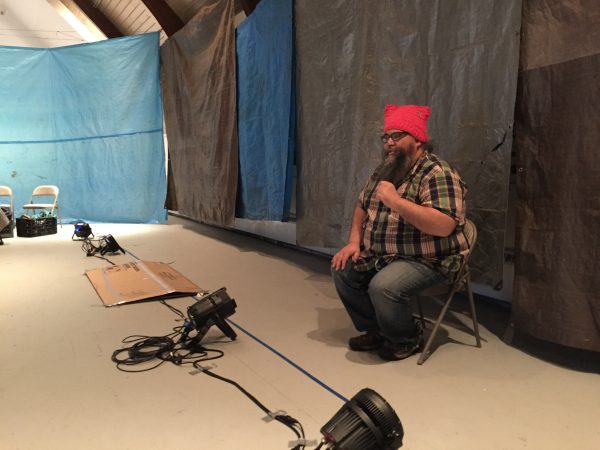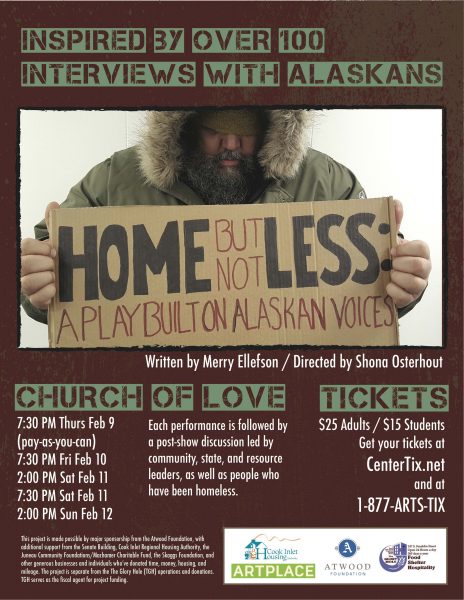
A new play showing in Anchorage this weekend tells the stories of homelessness from around the state. But for the writers and actors, “Home But Not Less” isn’t a story about sadness. It’s about understanding.
Rumpled tarps hang against the walls of an old church, serving as back drops for the eight actors that circle the audience’s seating area.
“So many of us live on the edge,” a man said.
“One medical incident,” added another.
“One pay check,” they all sang in chorus.
The lines are just snippets from over a hundred interviews with people who have experienced homelessness and those who offer services. Playwright Merry Ellefson began researching the play after meeting a young man who was living on the street and grieving the loss of his grandfather. She was hoping to understand not just what it was like to be without a home, but also what are the causes of homelessness in Alaska. She said everyone’s story starts in a different place.
“I’m sitting underneath a bridge and talking to someone whose parents encouraged him drink at age two and laughing,” Ellefson recalled. “His life trajectory is going to be a lot different than mine for a lot of different reasons.”
Through her interviews, Ellefson said she identified what her sources see as some of the major causes of homelessness: mental illness, housing, poverty, education, sexual abuse, domestic violence.
“Racism and discrimination play a huge part in this,” Ellefson said.
Many community leaders say racist policies, such as forcing Alaska Natives to attend boarding schools where they were punished for speaking their languages, caused many people to lose their identities. It led to inter-generational trauma, which some people Ellefson spoke with link to causes of homelessness.
Actor Austin Tagaban learned about some of these causes by participating in the production. He has never worried about being homeless, he said.
“If I didn’t have somewhere to sleep that night, I could call someone and be like, ‘Hey man,’ or ‘Hey, Mom, let me sleep on your couch.’ And she’d be like, ‘No, have this room Austin,’ Tagaban said.”
Tagaban had a safety net. He says he thought the answers to homelessness were simple — why couldn’t someone just get a job? But now he understands how complicated people’s lives are.
“It’s important to hear these stories because they’re people who we usually ignore,” Tagaban said. He thinks we can learn from them.
 One of those stories is from Michael Patterson, who first became homeless in Juneau when he was nine years old.
One of those stories is from Michael Patterson, who first became homeless in Juneau when he was nine years old.
“In the mornings, when the stores opened, I would steal fruits off the displays,” actor George Holly recited. “I lived like a rat, in a sense, so you know, my self-worth was, it was destroyed.”
For Holly, participating in the in play is personal. He said learning about the support networks available to people helped him alleviate some of his own fears about becoming homeless.
Director Shona Osterhout said that’s one of the main goals of the production — to develop empathy and solutions.
“This isn’t about being sad about our neighbors’ situation. This is actually about how do I learn about our neighbor’s situation. What can I do to help? And how do I just be a better human on the planet?” Osterhout said.
Each show will be followed by a panel discussion with local service providers. Writer Ellefson said she wants people to leave knowing ways they can get involved.
The play starts Thursday, Feb. 9 at the Church of Love in Spenard and will run through the weekend. Tickets are available at the door.
Anne Hillman is the healthy communities editor at Alaska Public Media and a host of Hometown, Alaska. Reach her atahillman@alaskapublic.org. Read more about Annehere.





